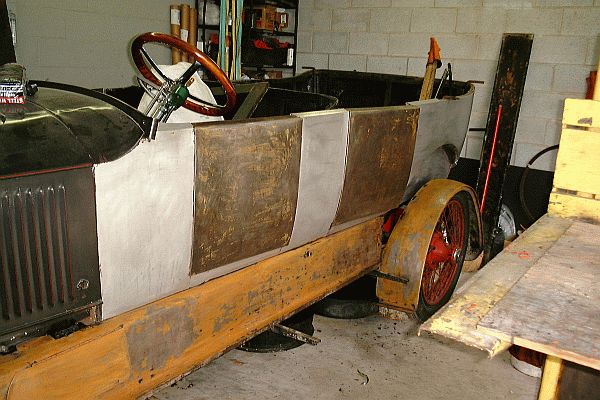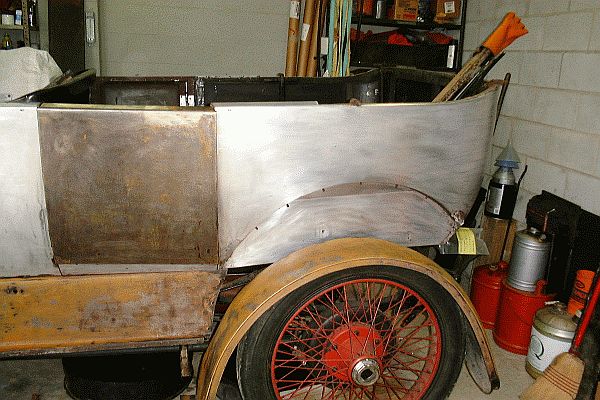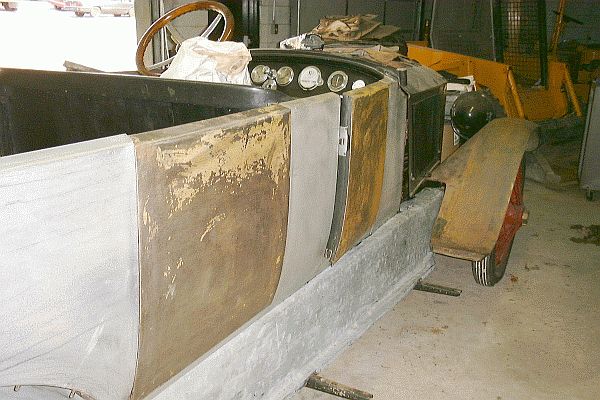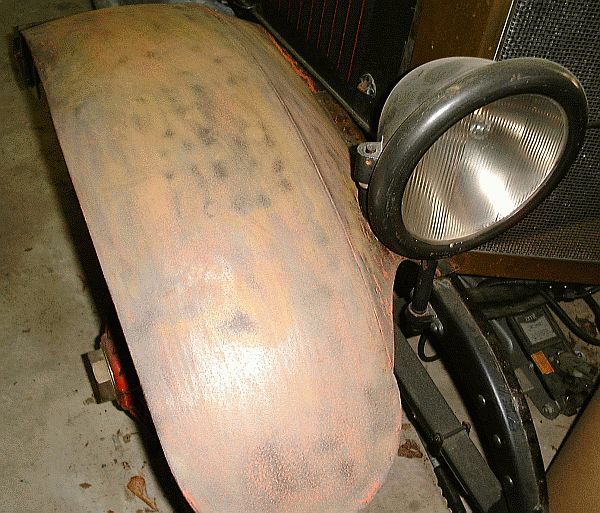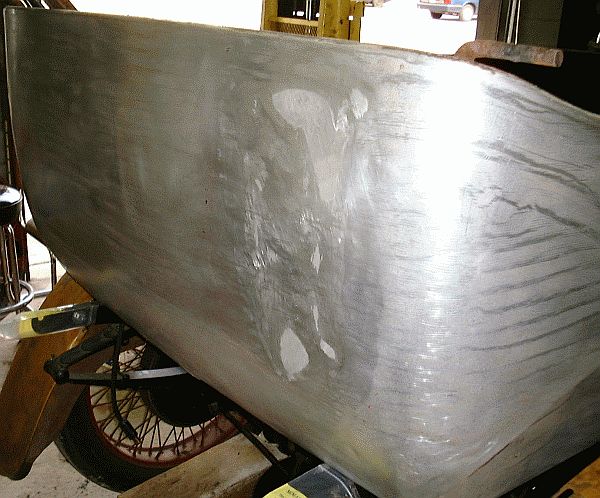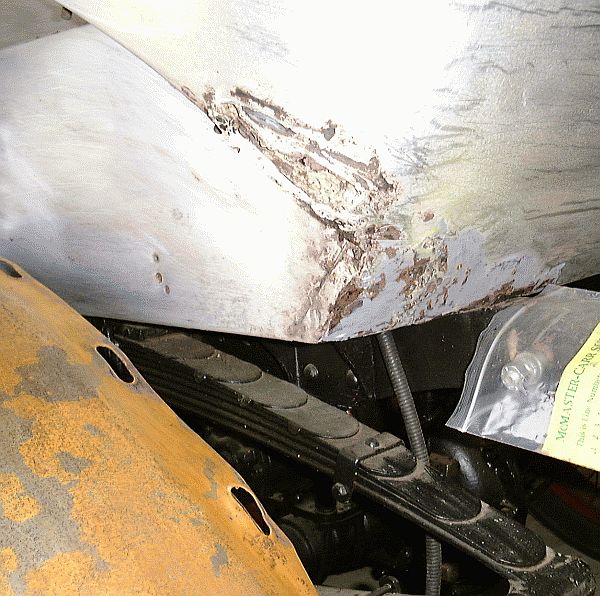|
The first step in the body restoration process was the removal of the existing paint and primer from the body. For this phase of the car's restoration to commence the interior of the car had to be removed. Please see the restoration section involving the upholstery for details on the removal and restoration of the interior. Once the interior leather had been removed full access to all body panels for restoration was possible.
Stanley built up the car's steel channel frame by installing the boiler, engine, axles, wheels and tires, braking hardware, steering mechanisms, tank, and interconnecting piping and automatics. Once these were installed the car's pre-painted body was literally set in place and bolted to the frame using six carriage bolts. The upholstery was then installed, the top installed, and the car readied for shipment to the buyer. The above photo shows the rear of the car with the rear seat and side wall upholstery removed. Clearly seen in this photo is the construction of the car's body. The body construction started with an oak frame base from which vertical supports were mounted. At the upper end of the vertical supports wooden pieces defined the top contours of the body. Formed aluminum panels were then literary nailed to the wooden framing members.
Paint stripping started by painting a small surface of the car with an application of Mar-Hyde Tal-Strip II Aircraft Coating Remover. Allowed to "work" for 20 minutes a second coat was applied and also allowed to "work". At this point the existing paint would have loosened from the metal as evidenced by a severe wrinkling of the paint film. The loosened paint film was easily shaved off the body panel using a hard plastic spatula. Remnants of the undercoat would remain but another application of stripper and a final rubbing with 3M Scotch-Brite pads removed any remaining paint. The photograph above shows the left side of the car having been stripped of paint from the hood area to the back. While the main body of the car is formed of heavy aluminum the doors, splash guard, and fenders were steel as evidenced by their rusting quickly after the paint had been removed.
Pictured above is the left rear quarter-panel of the car. The rear of the car was constructed from a single sheet of aluminum. That aluminum sheet started at the rear edge of the left rear passenger door, wrapped around the back of the vehicle, and ended at the rear edge of the right rear passenger door. To make this panel a single sheet of aluminum four feet wide and approximately tweleve feet long was required. It was then formed to desired shape probably by hand hammering over special forms and fixtures. Once formed the aluminum panel was secured to the oak body frame using nails. The rear wheel fender has been unbolted from the body and rests on the wheel. The rear wheel fenders are actually recessed into the body to allow for their mounting. The arc in the body which forms the wheel well is made from a steam-bent piece of heavy oak. The aluminum body is formed over the outer edge of the oak (attached with small nails) while another sheet of aluminum is attached to the inner edge of the oak (again nailed in place). 1/4" ~ 20 elevator bolts (also known as belt bolts, these bolts resemble a carriage bolt but instead of the small, thick rounded head have a large glat head about the size and thickness of a quarter) are mounted through the oak and are seen in the photograph. The steel wheel fender was held in place by with large diameter, thick fender washers and square-head nuts attached to the elevator bolts. Careful examination of the left rear passenger door reveals an area where little rust is present. This was the location of the original leather pad that served as the door handle.
The right side of the car is similar in appearance to that of the left side with the exception of the splash guard. During the 1950 through 1952 restoration the original splash guard between the running board and the body had been replaced. Originally of heavy steel, the replacement was fabricated of light galvanized steel. Since the galvanization had not been properly prepared the paint did not adhere to this panel and had started to flake off. At the front of the car is seen the front fender also now stripped of paint.
Close examination of the front fender shows it to be rich in craters from rust having occurred sometime in the car's past. The best explanation for the general condition of the car was that after it stopped providing personal transportation it had been stored somewhere that allowed rain to get to the body. The front right fender was heavily rusted and the splash panel might have been replaced simply because its damage was too extensive to repair. The hood panels on this side of the car also showed significant rusting once the paint had been removed. In addition to the rusting of the fender, reddish-orange traces of Nitro-Stan lacquer-based body filler remain in the rust craters after the paint was removed. Later sandblasting of the panels removed the rust as well as any traces of body fillers. The steel used to fabricate the fenders was very heavy gauge. If one were to sandblast a metal fender on a modern car the metal would curl and distort due to the effects of the sand particles hammering the metal at high velocity. The fenders of the Stanley were not only of sufficient thickness and strength to resist any deformation during sandblasting, the edges of the fenders were rolled over wire reinforcing adding further strength.
In the 1980s a minor accident occurred while the car was being driven by a student driver. Stanley brakes are known to be marginal at best when driving forward and "a wish and a prayer" when moving backwards due to their construction (hydraulic brakes were retrofitted to the car during the mechanical restoration to eliminate this safety hazard and concern). While moving in reverse the car mated with a steel roadway guard pole and damage to the right rear of the car resulted. Seen in the photograph above are the results of that accident. The right rear of the car had been heavily filled in with body filler and repainted (a different shade of gray). With the seats removed and full access to both sides of the aluminum panel it would now be possible to hammer out the heavy dents so that only minimal body fillers would be required. For this repair fiber-enhanced body fillers would be used to increase strength and durability.
With the paint removed from the car the actual condition of the body could be determined. The right-side fenders showed heavy rust craters. The right rear of the car had body damage from the earlier accident. The lower left rear corner of the body (pictured above) suffered severe deterioration. When the seats were removed the space occupied by the seat springs and support lumber was heavily filled with animal nests. The quantity of hazelnut shells, acorns, and other nuts indicated that quite a number of squirrels and mice had found the comfortable horse-hair of the seats a warm winter home in which to hibernate. The left rear corner of the car had definitely served as the "litter box". The acids in the waste materials had literally eaten the aluminum away at the back corner of the car. Some of the damage occurred prior to the restoration in the early 1950s as body filler was present after removing the gray paint. Obviously the car hosted descendents of the original wildlife since the 1950s restoration as additional damage had occurred. Parts of the aluminum body had been eaten away such that only the wood frame remained. While removing the paint from the car it had been hoped that a reminant of the original paint color might be uncovered. Whoever did the bodywork in the early 1950s did a through job of removing the original paint. No traces of the original color were ever discovered. |

